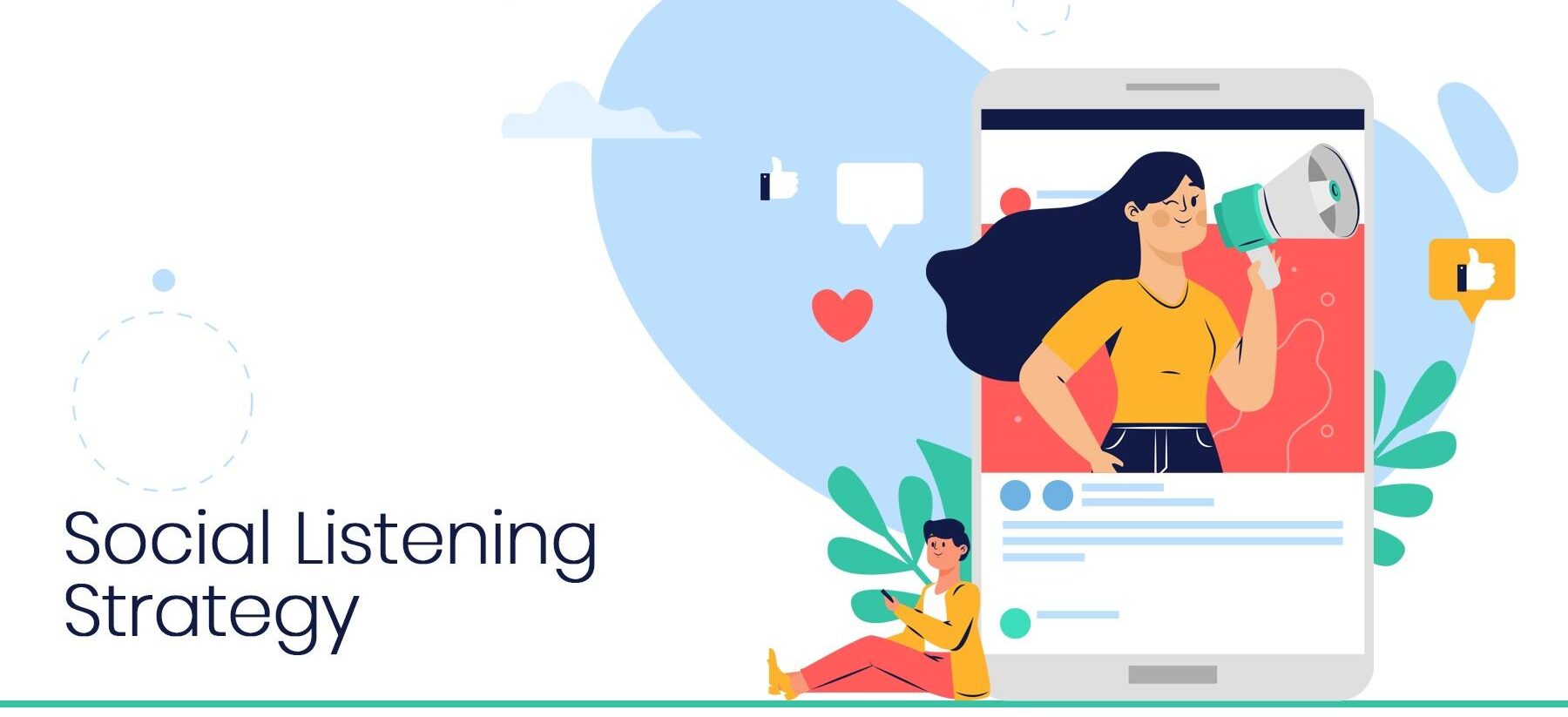In today’s fast-paced digital landscape, successful marketing requires more than just promoting products or services. It’s crucial to truly understand your target audience and engage with them in meaningful ways. This is where social listening comes into play. Social listening refers to the process of monitoring and analyzing conversations and trends across various social media platforms. By harnessing the power of social listening, businesses can gain valuable insights into their customers’ preferences, needs, and expectations. In this article, we will explore how social listening in marketing can be a game-changer for marketers and provide practical tips for leveraging this strategy to enhance your marketing efforts.
Why Is Social Listening In Marketing Important?

In an era where consumers have a myriad of choices and platforms to voice their opinions, social listening has become essential for marketers. Here are some key reasons why social listening is crucial for your marketing strategy:
- Understanding Customer Sentiments: Social listening allows you to gauge the overall sentiment towards your brand, products, or services. By identifying positive or negative sentiment trends, you can adapt your marketing approach and address any issues promptly.
- Uncovering Consumer Insights: By monitoring conversations related to your industry, competitors, or relevant topics, social listening can provide valuable insights into consumer needs, preferences, and pain points. These insights can inform your marketing campaigns, product development, and customer engagement strategies.
- Identifying Influencers and Brand Advocates: Social listening enables you to identify influential individuals who can positively impact your brand. By engaging with these influencers and brand advocates, you can amplify your message, expand your reach, and build strong relationships with key opinion leaders.
- Real-Time Crisis Management: Social media has the power to amplify both positive and negative experiences. By actively listening to social media conversations, you can identify potential crises early on and respond promptly to mitigate any reputational damage.
- Competitive Analysis: Social listening allows you to keep tabs on your competitors and their marketing efforts. By monitoring their strategies, campaigns, and customer feedback, you can gain a competitive edge and refine your marketing approach.
How To Implement An Effective Strategy?

Now that we understand the importance of social listening, let’s dive into some actionable steps to implement an effective strategy:
1. Set Clear Objectives: Define your goals and objectives for social listening. Determine what specific insights you are looking to gather and how they align with your overall marketing strategy.
2. Choose the Right Tools: There are numerous social listening tools available in the market. Research and select a tool that suits your needs, considering factors such as data accuracy, real-time monitoring, sentiment analysis, and competitive analysis capabilities.
3. Identify Relevant Keywords and Topics: Determine the keywords, hashtags, and topics that are relevant to your industry and brand. These will serve as the foundation for monitoring conversations and gathering insights.
4. Monitor Conversations and Mentions: Use your chosen social listening tool to monitor conversations, mentions, and hashtags across various social media platforms. Pay attention to both direct mentions of your brand and broader discussions related to your industry.
5. Analyze and Interpret Data: Once you have collected data, analyze it to uncover patterns, sentiments, and emerging trends. Look for common themes, recurring sentiments, and key customer insights. Use sentiment analysis tools to gauge the overall sentiment towards your brand and identify areas for improvement.
Read more about: Social Media Listening Case Study: How Aim Technologies’ Tool Empowered Vodafone Egypt for Business Growth
6. Engage with Your Audience: Social listening is not just about gathering data; it’s also about actively engaging with your audience. Respond to customer feedback, address their concerns, and participate in relevant conversations. This shows that you value their opinions and can help build stronger relationships with your customers.
7. Track Competitor Activity: Keep a close eye on your competitors’ social media activities. Monitor their campaigns, content, and customer interactions. Identify their strengths and weaknesses, and use these insights to refine your marketing strategies and stay ahead of the competition.
8. Leverage Influencers and Brand Advocates: Identify influential individuals in your industry who align with your brand values. Engage with them, collaborate on campaigns, or seek their endorsements. Influencers can help amplify your brand message and reach a wider audience.
9. Use Data to Inform Marketing Decisions: The insights gathered through social listening should inform your marketing decisions. Use the data to refine your messaging, tailor your content, and optimize your campaigns. This data-driven approach will help you create more targeted and effective marketing strategies.
10. Continuously Adapt and Improve: Social media trends and conversations are constantly evolving. Stay updated with the latest developments, monitor shifts in customer sentiments, and adapt your social listening strategy accordingly. Regularly review your objectives and refine your approach to ensure long-term success.
Case Study: How Social Listening Helped To Improve Customer Engagement and Product Development
A mid-sized clothing brand was struggling with keeping strong engagement with the target customers online. And staying updated with all the digital trends, although they were using social media for marketing campaigns.
Challenges
- Customer Sentiment Monitoring: They couldn’t have real-time insights about their customer opinion in the campaigns. Which leads to not adjusting them to match the customer’s interests.
- Product Development Issues: They were having a lot of customer feedback and complaints, but they were not able to analyze them. That delayed any development in the product or business.
- Limited Competitive Intelligence: They didn’t have an overview of their competitors in the market. Not knowing their strategies or the techniques they are following with customers.
Social Listening Strategy
The brand finds out that they are missing the social listening strategy, which will help them overcome their challenges. They depended on a social listening tool to provide them with the needed insights. Following the right steps to get the right results.
- Monitoring Conversations: They tracked the mentions of their brand name in all the conversations, and their competitors too. In addition to tracking the trends in the industry, and the top hashtags over social media.
- Sentiment Analysis: They analyzed their customer comments and feedback about their latest collections. To find out some complaints about fitting and designs.
- Competitive Monitoring: They tracked their competitor’s strategies and their customer’s feedback. To find opportunities to differentiate themselves out of the competition.
Results
- Improved Product Development: The brand started to adjust the size and fit based on customer preference. In addition to developing the designs to match the market needs and interests.
- Enhanced Customer Engagement: The brand started the participate in real-time conversations with their customers. Leading to an increase in the customer loyalty to the brand.
Key Components of Social Listening Tools
Effective social listening tools typically include:
- Data Collection: Gathering information from social media platforms, blogs, forums, and news sites.
- Analysis: Using algorithms to analyze sentiment, trends, and emerging topics.
- Reporting: Providing insights and visualizations that are easy to understand and act upon.
Benefits of Social Listening
1. Understanding Customer Sentiment
One of the most significant advantages of social listening is its ability to gauge customer sentiment. By analyzing how people feel about your brand and products, you can tailor your marketing strategies to better meet their needs and expectations.
2. Enhancing Customer Engagement
Social listening allows you to engage with your audience more effectively. By identifying what your customers are talking about, you can join conversations, offer solutions, and build stronger relationships with them.
3. Identifying Market Trends
Staying ahead of market trends is crucial for any business. Social listening provides early warnings about emerging trends, allowing you to adapt your strategies and stay competitive.
4. Improving Product Development
Listening to customer feedback can lead to valuable insights for product development. Understanding what customers like or dislike about your products helps you make informed decisions and improvements.
5. Crisis Management
In the age of social media, a brand crisis can escalate quickly. Social listening helps you detect potential issues early on, allowing you to address them before they spiral out of control.
Integrating Social Listening with Other Marketing Efforts
Social listening should not operate in isolation. Integrate it with your broader marketing strategy to ensure that the insights gained are used effectively. This integration can enhance your content marketing, SEO, and overall customer engagement efforts.
Top Social Listening Tools
1. Overview of Popular Tools
There are numerous social listening tools available, each with its unique features and strengths. Some of the top tools include:
- AIM Insights: Known for its powerful analytics and extensive data coverage.
- Hootsuite: Offers a comprehensive suite of social media management features.
- Sprout Social: Provides robust reporting and user-friendly interfaces.
2. Features to Look For
When choosing a social listening tool, consider the following features:
- Data Coverage: Ensure the tool covers a wide range of platforms and sources.
- Sentiment Analysis: Look for tools with advanced sentiment analysis capabilities.
- Customization: The ability to customize reports and dashboards to suit your needs.
3. Comparing Top Tools
Each social listening tool has its pros and cons. Compare them based on your specific requirements, such as budget, ease of use, and the depth of insights provided.
Challenges
1. Data Overload
One of the main challenges in social listening is dealing with the sheer volume of data. Sifting through this data to find actionable insights can be overwhelming.
2. Ensuring Data Accuracy
Ensuring the accuracy of the data collected is another challenge. Misinterpretations can lead to incorrect conclusions and misguided strategies.
3. Balancing Automation with Human Insight
While automation is crucial for handling large datasets, human insight is necessary for context and nuance. Striking the right balance between the two is key to effective social listening.
Future Trends
1. Advancements in AI and Machine Learning
The future of social listening lies in AI and machine learning. These technologies will continue to improve the accuracy and efficiency of data analysis, providing deeper insights and more predictive capabilities.
2. Increased Integration with Other Technologies
Social listening tools will become more integrated with other marketing technologies, such as CRM systems and analytics platforms, offering a more holistic view of data.
3. Growing Importance of Video and Image Analysis
As visual content becomes more prevalent, the ability to analyze video and images will become increasingly important in social listening. Advanced tools are already beginning to offer these capabilities, providing a more comprehensive understanding of online conversations.
Conclusion
Social listening is a powerful tool that can provide marketers with valuable insights into their target audience. By monitoring and analyzing social media conversations, businesses can gain a deeper understanding of customer sentiments, preferences, and emerging trends. Implementing an effective social listening strategy allows marketers to make data-driven decisions, engage with their audience, identify influencers, and stay ahead of the competition.
To harness the full potential of social listening and take your marketing efforts to the next level, consider partnering with AIM Technologies. Our innovative social listening platform offers advanced features, real-time monitoring, sentiment analysis, and comprehensive analytics to help you uncover actionable insights.
Don’t miss out on the opportunity to enhance your marketing strategy and drive better results. Request a demo of AIM Technologies today and discover how our solution can revolutionize your social listening efforts. Take the first step towards gaining a competitive edge in the digital landscape.
FAQs
Why is social listening considered crucial for understanding customer sentiment and needs?
Because it provides insights into the customer’s real opinions and emotions towards the business. And it monitors the customer needs through their conversations and feedback.
In what ways does social listening contribute to real-time crisis management on social media platforms?
By giving real-time data for the brand reputation and performance. And work on notifying the business when there are any crises or problems related to it across social media. Leading to control and manage it faster and smarter.
How can selecting the right social listening tools influence the success of a marketing campaign?
As the right tool will provide the right needed insights for the business, and work on improving it. By providing the necessary features, the business could use it effectively.
What challenges do marketers face when using social listening tools?
The amount and quality of the data that the tools provide. And how to use these data effectively in their strategies. In addition to not having the insights that they are looking for in the market.
How does social listening help with competitive analysis?
With giving deeper insights and reports about the competitor strategies and techniques in the market. And how to compare with them, and how their target audience are picturing them.




